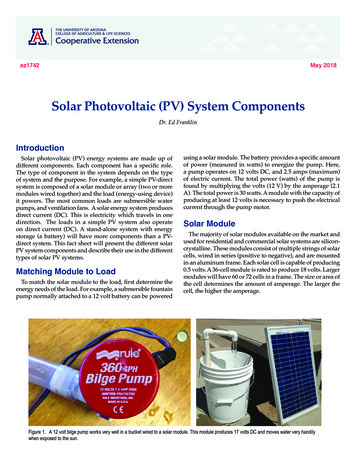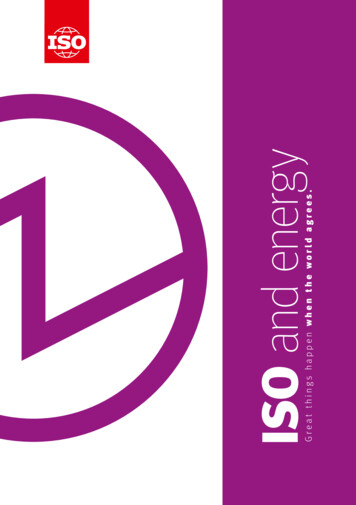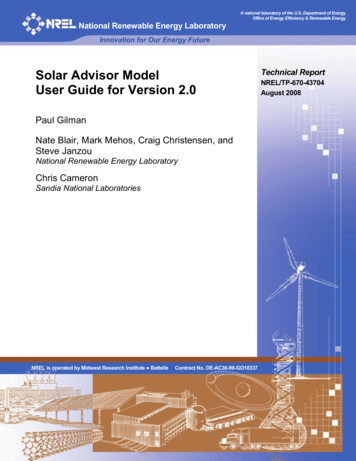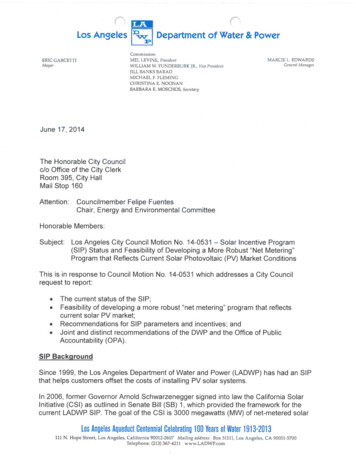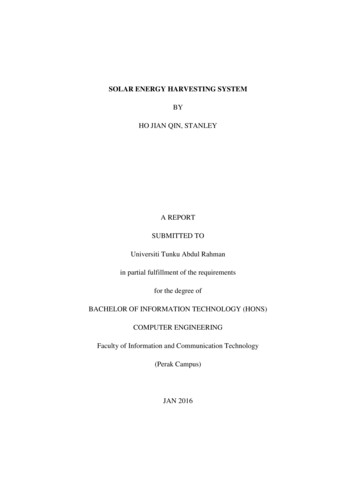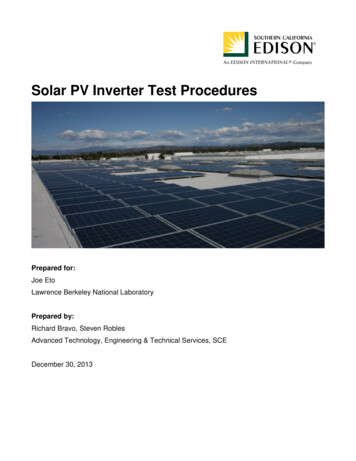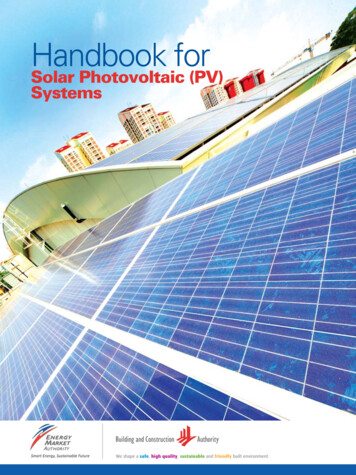
Transcription
Handbook forSolar Photovoltaic (PV)Systems1
Contents1Solar Photovoltaic (“PV”) Systems – An Overview1.1 Introduction1.2 Types of Solar PV System1.3 Solar PV Technology Crystalline Silicon and Thin Film Technologies Conversion Efficiency Effects of Temperature1.4 Technical Information4456889102Solar PV Systems on a Building2.1 Introduction2.2 Installation Angle2.3 Avoid Shading PV Modules2.4 Aesthetic and Creative Approaches in Mounting PV Modules2.5 Solar PV Output Profile2.6 Solar PV Yield2.7 Cost of a Solar PV System12121213141415153Appointing a Solar PV System Contractor3.1 Introduction3.2 Getting Started Get an Experienced and Licensed Contractor Choosing Between Bids Solar PV System Warranty Regular Maintenance Other Relevant Matters16161717171719194Solar PV System Installation Requirements4.1 Electrical Installation Licence4.2 Electrical Safety Standards and Requirements4.3 Application of Electrical Installation Licence4.4 Conservation and Development Control Requirements4.5 Guidelines on Conservation and Development Control4.6 Structural Safety and Lightning Protection Structural Safety Lightning Protection4.7 Connection to the Power Grid4.8 Get Connected to the Power Grid4.9 Sale of Solar PV Electricity4.10 Design and Installation Checklist202020212121222222222323275Operations and Maintenance5.1 Operations of Solar PV Systems5.2 Recommended Preventive Maintenance Works282829
AppendicesAppendix A – Examples of solar pv system on buildings insingaporeA.1ZERO ENERGY BUILDING @ BCA Academy32A.2POH ERN SHIH (TEMPLE OF THANKSGIVING)34A.3313 SOMERSET CENTRAL36A.4Sentosa Cove38A.5Marina Barrage40A.6Lonza Biologics42A.7Zero Energy House44A.8Tampines Grande46A.9 HDB APARTMENT BLOCKS AT Serangoon North PrecinctA.10 HDB APARTMENT BLOCKS AT Wellington Circle Precinct4850Appendix BB.1Engaging a Licensed Electrical Worker52Appendix CC.1CONTACT INFORMATION54Appendix D – INCENTIVES FOR SOLAR PV SYSTEMD.1Solar Capability Scheme (SCS)55D.2 Market Development Fund (MDF)56D.3 Green Mark Scheme57D.4 Green Mark Gross Floor Area (GM-GFA) Incentive Scheme58D.5 100 million Green Mark Incentive SchemeFor existing buildings (GMIS-EB)59D.6 Enhanced 20 million Green Mark Incentive Scheme fornew buildings (GMIS-NB)601
ForewordCognizant of the growing popularity of solar photovoltaic (PV) installations amongst residentialdwellers as well as building developers, and the corresponding demand for a comprehensiveset of technical and regulatory information, the Energy Market Authority (EMA) and the BuildingConstruction Authority (BCA) got together earlier this year to work on integrating their respectivesolar manuals into an all-in-one reference guide for those who are keen on installing solar PVsystems in Singapore.The outcome of this joint project, which also saw the involvement of industry partners andstakeholders such as Phoenix Solar Pte Ltd, Grenzone Pte Ltd, Solar Energy Research Instituteof Singapore (SERIS) and Singapore Polytechnic, is this “Handbook for Solar Photovoltaic (PV)Systems”. Through this integrated and revised handbook, we hope to be able to provide acomprehensive guide to the relevant parties, including owners, developers, engineers, architects,Licensed Electrical Workers and electricians on the key issues, requirements and processespertaining to the installation of solar PV systems.As with the previous edition of the handbooks, this single volume covers and provides informationon licensing, market and technical requirements, and building and structural issues that are relatedto the implementation of solar PV systems in a building environment. In addition, it provides newinformation on the installation requirements for solar PV systems, operations and recommendedpreventive maintenance works, and various incentives to promote solar PV systems in Singapore.We have also refreshed the presentation of the handbook to make it more accessible and readerfriendly, as well as to incorporate examples of completed solar PV installations in Singapore.We hope you will find this to be a useful guide.David TanDeputy Chief ExecutiveEnergy Planning and Development DivisionEnergy Market Authority2Ang Kian SengDirectorCentre of Sustainable Building & ConstructionBuilding and Construction Authority
AcknowledgementsWe would like to thank the following organisations for their support and contributions inthe development of this handbook:1)Grenzone Pte Ltd2)Phoenix Solar Pte Ltd3)Singapore Polytechnic4)Solar Energy Research Institute of Singapore (SERIS)5)SP PowerGrid6)Urban Redevelopment Authority3
1Solar Photovoltaic(“PV”) Systems –An Overview1.1IntroductionThe sun delivers its energy to us in two main forms: heat and light. There are two maintypes of solar power systems, namely, solar thermal systems that trap heat to warm upwater, and solar PV systems that convert sunlight directly into electricity as shown inFigure 1.Figure 1. The difference between solar thermal and solar PV systemsWhen the PV modules are exposed to sunlight, they generate direct current (“DC”)electricity. An inverter then converts the DC into alternating current (“AC”) electricity,so that it can feed into one of the building’s AC distribution boards (“ACDB”) withoutaffecting the quality of power supply.4
Chapter 1Solar Photovoltaic (“PV”) Systems – An Overview1.2Types of Solar PV SystemSolar PV systems can be classified based on the end-use application of the technology.There are two main types of solar PV systems: grid-connected (or grid-tied) and off-grid(or stand alone) solar PV systems.Grid-connected solar PV systemsThe main application of solar PV in Singapore is grid-connected, as Singapore’s mainisland is well covered by the national power grid. Most solar PV systems are installedon buildings or mounted on the ground if land is not a constraint. For buildings, they areeither mounted on the roof or integrated into the building. The latter is also known asBuilding Integrated Photovoltaics (“BIPV”). With BIPV, the PV module usually displacesanother building component, e.g. window glass or roof/wall cladding, thereby serving adual purpose and offsetting some costs.The configuration of a grid-connected solar PV system is shown in Figure 2.Figure 2. Grid-connected solar PV system configurationA building has two parallel power supplies, one from the solar PV system and the otherfrom the power grid. The combined power supply feeds all the loads connected to themain ACDB.The ratio of solar PV supply to power grid supply varies, depending on the size of thesolar PV system. Whenever the solar PV supply exceeds the building’s demand, excesselectricity will be exported into the grid. When there is no sunlight to generate PVelectricity at night, the power grid will supply all of the building’s demand.5
Chapter 1Solar Photovoltaic (“PV”) Systems – An OverviewA grid-connected system can be an effective way to reduce your dependence on utilitypower, increase renewable energy production, and improve the environment.Off-grid solar PV systemsOff-grid solar PV systems are applicable for areas without power grid. Currently, suchsolar PV systems are usually installed at isolated sites where the power grid is far away,such as rural areas or off-shore islands. But they may also be installed within the city insituations where it is inconvenient or too costly to tap electricity from the power grid.For example, in Singapore, several URA parking sign lights are powered by off-grid solarPV systems.An off-grid solar PV system needs deep cycle rechargeable batteries such as lead-acid,nickel-cadmium or lithium-ion batteries to store electricity for use under conditionswhere there is little or no output from the solar PV system, such as during the night, asshown in Figure 3 below.Figure 3. Off-grid solar PV system configuration1.3Solar PV TechnologyThis section gives a brief description of the solar PV technology and the commontechnical terms used.A solar PV system is powered by many crystalline or thin film PV modules. IndividualPV cells are interconnected to form a PV module. This takes the form of a panel for easyinstallation.6
Chapter 1Solar Photovoltaic (“PV”) Systems – An OverviewMono-Crystalline Silicon PV CellPoly-Crystalline Silicon PV CellFigure 4. Mono-and Poly-Crystalline Silicon PV CellPV cells are made of light-sensitive semiconductor materials that use photons to dislodgeelectrons to drive an electric current. There are two broad categories of technology usedfor PV cells, namely, crystalline silicon, as shown in Figure 4 which accounts for themajority of PV cell production; and thin film, which is newer and growing in popularity.The “family tree” in Figure 5 gives an overview of these technologies available todayand Figure 6 illustrates some of these technologies.PV Cell TypesCrystalline Silicon(wafer based)Thin crystallineTandema-Si/microcrystallineCompound semiconductoreg GaAs-basedCIGS(Copper Indium GalliumSelenide)CdTe(Cadmium Telluride)Dye-sensitised (TiO2)Commerciallyavailable product,suitable for SingaporeR&D or pilot stage, orunsuitable forSingaporeFigure 5. PV technology family tree7
Chapter 1Solar Photovoltaic (“PV”) Systems – An iconFlexible amorphousthin filmCIGS thin filmFigure 6. Common PV module technologiesCrystalline Silicon and Thin Film TechnologiesCrystalline cells are made from ultra-pure silicon raw material such as those used insemiconductor chips. They use silicon wafers that are typically 150-200 microns (onefifth of a millimetre) thick.Thin film is made by depositing layers of semiconductor material barely 0.3 to 2micrometres thick onto glass or stainless steel substrates. As the semiconductor layersare so thin, the costs of raw material are much lower than the capital equipment andprocessing costs.Conversion EfficiencyTechnologyMono-crystalline SiliconPoly-crystalline SiliconCopper Indium Gallium Selenide (CIGS)Cadmium Telluride (CdTe)Amorphous Silicon (a-Si)Module Efficiency12.5-15%11-14%10-13%9-12%5-7%Table 1. Conversion efficiencies of various PV module technologiesApart from aesthetic differences, the most obvious difference amongst PV celltechnologies is in its conversion efficiency, as summarised in Table 1.For example, a thin film amorphous silicon PV array will need close to twice the spaceof a crystalline silicon PV array because its module efficiency is halved, for the samenominal capacity under Standard Test Conditions1 (STC) rating.Standard Test Conditions refer to the following testing conditions: 1,000W/m2 of sunlight 250C cell temperature Spectrum at air mass of 1.518
Chapter 1Solar Photovoltaic (“PV”) Systems – An OverviewFor crystalline silicon PV modules, the module efficiency is lower compared to the sumof the component cell efficiency due to the presence of gaps between the cells and theborder around the circuit i.e., wasted space that does not generate any power hencelower total efficiency.Effects of TemperatureAnother important differentiator in solar PV performance, especially in hot climates, isthe temperature coefficient of power. PV cell performance declines as cell temperaturerises.For example, in bright sunlight, cell temperatures in Singapore can reach over 70ºC,whereas PV modules are rated at a cell temperature of 25ºC. The loss in power outputat 70ºC is therefore measured as (70 - 25) x temperature coefficient.Most thin film technologies have a lower negative temperature coefficient compared tocrystalline technologies. In other words, they tend to lose less of their rated capacity astemperature rises. Hence, under Singapore’s climatic condition, thin film technologieswill generate 5-10% more electricity per year.A PV module data sheet should specify the temperature coefficient. See Table 2 andchart in Figure 7.Technology Temperature Coefficient[%/ C]Crystalline silicon-0.4 to -0.5CIGS-0.32 to -0.36CdTe-0.25a-Si-0.21module output relative to STCTable 2. Temperature coefficient of various PV cell technologesFigure 7. The effects of a negative temperaturecoefficient of power on PV module performance9
Chapter 1Solar Photovoltaic (“PV”) Systems – An OverviewThe PV modules are next connected in series into a PV string as shown in Figure 8.A PV array as shown in Figure 9 is formed by the parallel aggregation of PV strings.Figure 9. PV ArrayFigure 8. PV String1.4Technical InformationSingle-core, double isolated sheathed cables that can withstand the environmentalconditions, and minimise the risk of earth faults and short circuits are used to interconnectthe PV strings and arrays. The cable connections are protected in enclosures known asjunction box that provides the necessary connectors as shown in Figure 10.Figure 10. Junction BoxElectricity produced by the solar PV installation is in the form of DC. The output of thePV installation is connected through the DC main cables to the DC terminals of the PVinverter where electricity is converted from DC into AC.After conversion, the AC current of the PV inverter is connected through PV supplycable to the building’s electrical installation (AC distribution board).Figure 11 shows a typical PV inverter connected to the electrical installation of abuilding. Note that the actual configuration of the PV inverter may vary across differentsystems.10
Chapter 1Solar Photovoltaic (“PV”) Systems – An OverviewDC SideAC SidePVInverterAC DistributionBoardPV DC MainCablePV SupplyCableFigure 11. Typical PV inverter connected to abuilding’s electrical installationJust like any electrical installation in a building, earthing is an important safety requirementfor solar PV system. Arrangement must be made for proper connection of the solar PVsystem to the consumer’s electrical installation earthing system.In locations susceptible to lightning strikes, a lightning protection system must beprovided, and all the exposed metallic structures of the solar PV system must be boundto the lightning earthing system.It is the responsibility of the consumers to have their solar PV systems maintainedregularly to ensure safe operation of their solar PV systems and electrical installations.See Figure 12 for a diagram showing the solar PV system forming part of a consumer’selectrical installation.Figure 12. Solar PV system forming part of a consumer’s electrical installation11
2Solar PV Systemson a Building2.1IntroductionThere are many examples overseas where PV modules are mounted on the roof andintegrated into building façades. They work particularly well in Europe and North America,as south-facing façades in these regions are well exposed to the sun.In Singapore, we have to consider that the sun passes almost directly overhead. This isbecause we are located near the Equator, and the path of the sun follows the Equator,owith seasonal variations of up to 23.5 to the north or south. Therefore there are optimalpositions to locate the PV modules that have to be taken into consideration. Refer toAppendix A for examples of solar PV systems on buildings in Singapore.2.2Installation AngleTo maximise electricity production for use in Singapore, the best location for thePV modules to be installed is right on top of a building, facing the sky. The possibleinstallation options are shown in Figure 13.Figure 13. Where to install PV modules on a building in Singapore12
Chapter 2Solar PV Systems on a BuildingVertical façades and steeply sloped roofs tend to suffer a big loss in the ability to generateelectricity in exchange for higher public visibility.With the PV modules facing the sky, it is possible to improve the yield by installing PVmodules on trackers to follow the sun from east to west during the day (single-axistrackers), and from north to south during seasonal changes (dual-axis trackers).However, trackers can only improve system performance under direct sunshine, andthey give no advantage in diffused sunlight conditions, such as on cloudy or hazy days.The down side of having flat-mounted PV modules is that they tend to get dirty fromrain water and dust. See Figure 14. It is therefore better to mount the PV modules at anooincline (10-15 for framed modules, or as little as 3-5 for unframed modules), to allowrain water to properly drain offFigure 14. PV module frames trap dirt as water evaporates from aflat-mounted PV module2.3Avoid Shading PV ModulesPV modules should be free from shade. Shading of any single cell of a crystalline siliconPV module will drastically reduce the output of the entire PV module.Thin film PV modules are more tolerant to partial shading than crystalline silicon PVmodules. Typical culprits include shadows cast by tall trees and neighbouring buildings.13
Chapter 2Solar PV Systems on a Building2.4Aesthetic and Creative Approaches in Mounting PV ModulesBesides mounting PV modules on the rooftop, customised PV modules can beintegrated into the building façade in a creative, aesthetically pleasing manner. They canbe mounted on any part of the rooftop or external walls that is well exposed to sunlighte.g. skylights, cladding, windows, and external shading devices.They can also be integrated into external structures such as façades and canopies, asshown in Figure 15 and Figure 16, respectively.Figure 15. BIPV modules integratedinto a façadeFigure 16. BIPV modules integrated into askylight canopy2.5Solar PV Output ProfileSolar PV only produces electricity when sunlight is available. The output of a solar PVsystem varies with its rated output, temperature, weather conditions, and time of theday. The power output profile of the PV installation as shown in Figure 17, at a selectedtest site in Singapore collected over a period from 2002-2004, in terms of its capacityfactor2 , shows a high variation of solar PV output.[2] PV Output capacity factor Ratio of the actual output of the PV installation at time (t) over its output if ithad operated at full rated output.14
PV output capacity factorChapter 2Solar PV Systems on a BuildingFigure 17. Varying daily power output profile of PV installationat a selected test site in Singapore2.6Solar PV YieldThe amount of electricity you are able to generate from a solar PV system depends notonly on the availability of sunshine but also on the technology you choose to install. Forexample, a typical 10-kW rooftop solar PV system in Singapore would produce about11,000 to 12,500 kWh annually using crystalline PV modules, and 12,000 to 14,500 kWhannually with amorphous silicon thin film PV modules.2.7Cost of a Solar PV SystemThe cost of your solar PV system will depend on many factors: system configuration,equipment options, labour cost and financing cost. Prices also vary depending on factorssuch as whether or not your home is new, and whether the PV modules are integratedinto the roof or mounted on the roof. The cost also depends on the system size orrating, and the amount of electricity it produces.Generally, solar PV systems entail high capital costs. With solar power, you can save onthe purchase of electricity from the grid. But even with these savings, it will take a longtime to recover the capital cost of the solar PV installation. The operating costs for solarPV installations are negligible, but the annual maintenance cost beyond the warrantyperiod may amount to 0.5% to 1% of the capital cost of the installation.Therefore on an overall basis, solar PV-derived electricity is still much more expensivethan that from the power grid. However, the cost of solar PV has historically been fallingby about 4% a year, and if this continues, solar PV may be competitive within the next10 years. For incentives on solar PV system, please refer to Appendix D.15
3Appointing aSolar PV SystemContractor3.1IntroductionYou will need to select a contractor to install your solar PV system. If interested, youmay check with the following organisations for some solar PV system designers andcontractors: The List of Solar PV System companies in Singapore, available from SustainableEnergy Association of Singapore, by calling 6338 8578 or by ittees/cleanenergy/54 The Singapore Sustainable Development Industry Directory 2008/2009, availablefrom the Singapore Business Federation, by calling 6827 6838 or by industrydirectory.jspYour contractor will appoint a Licensed Electrical Worker (“LEW”) who will be responsiblefor the design, installation, testing, commissioning, and maintenance of your solar PVsystem.In the case of non-residential electrical installations that require an electrical installationlicence, the appointed LEW who supervises the electrical work (“Design LEW”) maynot be the one who takes charge of your electrical installation (“Installation LEW”). TheDesign LEW will then have to work with the Installation LEW to work out the technicalissues.Please refer to Appendix B for details on how you can engage an LEW and the necessaryconsultation process.16
Chapter 3Appointing a Solar PV System Contractor3.2Getting StartedFirst, compile a list of potential solar PV system contractors. Next, contact thecontractors to find out the products and services they offer. The following pointers maygive consumers a good sense of the contractor’s capabilities:Get an experienced and licensed contractorExperience in installing grid-connected solar PV systems is invaluable, because someelements of the installation process, particularly interconnection with the grid, areunique to these systems. A contractor with years of experience will also demonstratean ability to work with consumers, and price their products and services competitively.It is also important to get a contractor who is an LEW.Choosing between bidsIf there are several bids for the installation of a solar PV system (it is generally a goodpractice to obtain multiple bids), consumers should take steps to ensure that all ofthe bids received are made on the same basis. Comparing a bid for a solar PV systemmounted on the ground against another bid for a rooftop system is like comparing applesto oranges.Bids should clearly state the maximum generating capacity of the solar PV system[measured in watts peak (Wp) or kilowatts peak (kWp)]. If possible, the bids shouldspecify the system capacity in AC watts, or specify the output of the system at theinverter.Bids should also include the total cost of getting the solar PV system components,including hardware, software, supporting structure, meter, installation, connection to thegrid (if applicable), permitting, goods and services tax, warranty, and future maintenancecost (if applicable).Solar PV system warrantyA solar PV system is an investment that should last a long time, typically two to threedecades for grid-connected applications. The industry standard for a PV module warrantyis 20-25 years on the power output.There are two main components to a PV module warranty: A workmanship warranty that offers to repair, replace or refund the purchasein case of defects. The period varies from one to as long as ten years,depending on the manufacturer. Two to five years is typical; and17
Chapter 3Appointing a Solar PV System Contractor A limited power output warranty that offers a variety of remedies in case thePV module’s output under STC drops below certain level. Most manufacturerswarrant at least 90% of the minimum rated output for 10 years, and 80% ofthe minimum rated output for 20-25 years. Take note that the minimum ratedoutput is usually defined as 95% of the rated output to allow for manufacturingand measurement tolerances. See Figure 18 for details.Figure 18. Understanding a manufacturer’s limited power warrantyTake note that under the limited power warranty, manufacturers seldom offer to replacethe PV module itself. Rather, at their sole discretion, they may offer to: Repair the defective PV modules; Supply enough new PV modules to replace the lost power output in a PVarray. For example, if your 20kW PV array only produces 16.1kW under STC,six years after installation, the manufacturer may opt to supply you with 1kWof PV modules to make up for the shortfall; or Refund you for the lost power output, after deduction according to the numberof years in use. For a 25-year warranty, the annual deduction is normally 4%.For example, if you find that your 20kW PV array only produces 16.1kW underSTC, six years after installation, the manufacturer may opt to reimburse yourpurchase price minus 24% (6 years x 4%).In all cases, the manufacturer does not cover your costs of dismounting, transporting,and reinstalling the PV modules. The warranty also excludes problems resulting fromimproper installations; repairs, changes or dismounting by unqualified personnel;accidental breakage or abuse; lightning strikes and other acts of God.18
Chapter 3Appointing a Solar PV System ContractorSignificantly, most manufacturers specify that the PV module output will be determinedby the flash testers in their own premises, rather than by a third party.The solar PV system contractor should assist in determining whether a PV moduledefect is covered by warranty, and should handle the situation with the manufacturer.Regular maintenanceDuring the defect liability period (usually for 12 months after installation), solar PV systemcontractors usually use remote monitoring data to prepare monthly performance reportsof the installed solar PV system. They should come on site to rectify any problemsflagged by the remote monitoring service.Other relevant mattersAnother matter to be aware of is that PV module manufacturers are constantly upgradingtheir products, and adapting new sizes and dimensions to suit market requirements.This means that you may no longer be able to buy an identical PV module to replacea defective one in your PV array a few years after installation. Newer PV modules arelikely to be more efficient or have different physical dimensions, and may no longer fitexactly into the gap left by the old PV module.This does not matter much on a large, ground-mounted solar PV power plant, becausethe new modules can form a new row. But on a building-mounted solar PV system itmay spoil the aesthetics, and may cause problems to the electrical configuration.19
4Solar PV SystemInstallationRequirements4.1Electrical Installation LicenceAn electrical installation refers to any electrical wiring, fitting or apparatus used forthe conveyance and control of electricity in any premises. A solar PV system installedwithin such premises forms part of the consumer’s electrical installation and shouldcomply with the requirements stipulated in the Electricity Act (Cap. 89A), the Electricity(Electrical Installations) Regulations and the Singapore Standard CP5 Code of Practicefor Electrical Installations.Under the Electricity Act, the Energy Market Authority (“EMA”) licenses all nonresidential electrical installations, with demand exceeding 45 kilo volt ampere or kVA. Forresidential electrical installations and non-residential electrical installations with demandbelow the threshold 45kVA, no electrical installation licence is required.The licence requires the owner of the electrical installation to engage an LEW to takecharge of the electrical installation and comply with the relevant safety standards andrequirements. Your appointed LEW shall consult SP PowerGrid Ltd on their technicalrequirements and procedures, if you wish to operate your solar PV system in parallelwith the power grid. The objective is to ensure all electrical installations, including solarPV systems, are safe to use.4.2Electrical Safety Standards and RequirementsA grid-connected solar PV system operates in parallel with the power grid supply. Thepower grid supply is considered the source, and the electrical installation with the solarPV system connected is considered as the load.The technical requirement for installation of a solar PV system is given in Section 612 ofthe Singapore Standard CP5.There are international product standards on PV modules and electrical components. Forexample, PV modules should comply with the requirements of IEC 61215 for crystallinesilicon terrestrial PV modules or IEC 61646 for thin-film terrestrial PV modules. Inaddition, PV array junction box, PV generator junction box and switchgear assembliesshould comply with the requirements of IEC 60439-1.20
Chapter 4Solar PV System Installation Requirements4.3Application of Electrical Installation LicenceYour LEW will be able to advise you whether you need to apply to EMA for an ElectricalInstallation Licence for the use or operation of the electrical installation within thepremises of your building.If an Electrical Installation Licence is needed, your LEW will submit the licence applicationto EMA on your behalf. If you already have an Electrical Installation Licence issued byEMA, you need not apply for a separate licence for the solar PV system within the samepremises.The electrical licence fee payable to EMA is 100 per year (exclusive of goods andservices tax).4.4Conservation and Development Control RequirementsAt present, there is no specific requirement or control by the Urban RedevelopmentAuthority (“URA”) on the use of installations such as a solar PV system. However,conservation projects, or projects within the Central Area are subject to URA’s UrbanDesign evaluation process.The standard development control guidelines apply to projects that may not be subjectto conservation or urban design requirements, depending on which structure(s) thesolar PV system is installed onto. For example, if a solar PV system is installed on therooftop of an attic, then the attic guidelines will apply. Likewise, if a solar PV system isinstalled on raised structures like a pavilion, then the pavilion guidelines will apply.4.5Guidelines on Conservation and Development ControlArchitects are advised to re
R&D or pilot stage, or unsuitable for Singapore Special Compound semiconductor eg GaAs-based Crystalline Silicon (wafer based) Thin Film PV cells are made of light-sensitive semiconductor materials that use photons to dislodge electrons to drive an electric c

